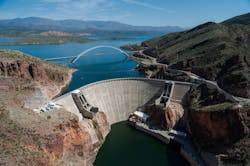Salt River Project modernizes four hydroelectric dams
Emerson reported Sept. 30 that it’s completed a multi-year modernization project at four Salt River Project (SRP) hydroelectric dams along the Salt River in Arizona. SRP’s Roosevelt, Horse Mesa, Mormon Flat and Stewart Mountain dams generate 265 megawatts of hydropower, which is enough to power more than 60,000 homes annually (Figure 1).
“As the long-time operator of the Bureau of Reclamation’s dams, we’re responsibility for delivering the reliable, clean and continuous power the community depends on,” says Shari Brady, hydroelectrical engineer at SRP. “By standardizing on Ovation for excitation and plant control across our hydroelectric fleet, and closely collaborating among our project teams, we completed all system installations on time, even though they had aggressive schedules. We now have greater operational insight and easier troubleshooting, which helps us maintain unit reliability in the 90th percentile.”
Two of the custom Ovation Excitation Systems that SRP implemented are for pump and energy storage units. They require unique integration when switching to pump mode, and are integrated into the utility’s existing Ovation DCS. The new, cohesive plant system improves SRP’s hydroelectric capabilities, which help strengthen local grid reliability, and enable it to use more renewable energy resources like solar and wind. SRP’s newly integrated automation platform also simplifies operations and maintenance by using the same spare parts, streamlining training, maintaining operator familiarity, and managing a single point of contact for automation support and service.
“Increased visibility and reliability of hydroelectric operations helps Salt River Project ensure continuous operations, and efficiently supply the power its customers rely on 24/7,” adds Bob Yeager, president of Emerson’s power and water business. “SRP’s vision for standardizing on a unified automation system was a transformative step that will position them for success for decades to come, even in the face of shifting energy markets and increased need for power.”
About the Author

Leaders relevant to this article:


